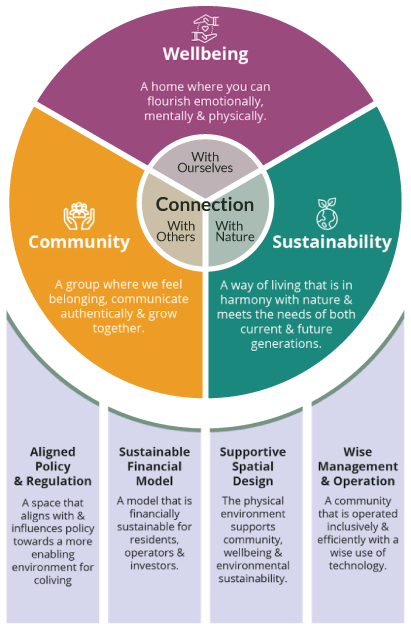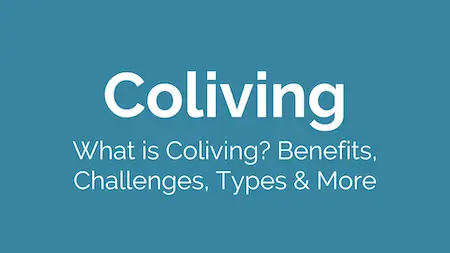Coliving spaces have emerged over the past few years offering community and convenience. However, the sector has not yet reached its full potential in fostering happy, healthy communities as well as resilient and sustainable societies.
Since 2018 we have collaborated with operators, developers, investors, organisations, thought leaders, and residents to develop a deeper and more holistic vision for coliving, one that can support coliving in fulfilling its full potential.
This crowdsourced research has been captured in an open-source framework:
The Conscious Coliving Manifesto v3.0


The Conscious Coliving Manifesto was born out of a realization that the world is suffering from a great crisis of disconnection. As such, the Manifesto embraces connection with self, others, and nature as its central element.
This framework serves as a guide for building connection-centered communities. The four pillars of the Manifesto underpin the three essential components of conscious shared living spaces: wellbeing, sustainability, and community. By creating such communities, we can shift towards a happier, healthier and more sustainable world.
The Conscious Coliving Manifesto, while can be applied to a variety of communities, has been developed primarily by and for professionally managed shared living businesses and communities (but not only!). It serves as a guide and framework for how to develop connection-centered shared living communities. Below, we outline the context behind the Manifesto and discuss each section in more detail.
Disconnection is at the Root of our Global Crises
Humanity is experiencing a serious metacrisis of disconnection. Social media, consumerism, urbanization, workaholism, emotional repression, and hyper-individualization have all contributed to us becoming increasingly disconnected from ourselves, others, and nature. Disconnection, in turn, is at the root of the growing loneliness and mental health epidemics, as well as the environmental and housing crises.
- Loneliness and Mental Health Crises: According to Johann Hari, award-winning investigative journalist and author of the New York Times best-selling book Lost Connections, loneliness and depression are a product of the way we live. People living in the modern westernized world are depressed because they are grieving the lost connections that all humans need to be happy, fulfilled and mentally healthy.
- Climate & Biodiversity Crisis: In addition, humans’ exploitation of and domination over Earth‘s abundant natural resources has disconnected us from being in balance with the most important system on the planet: our global ecosystem. The results of this disconnection — the climate and biodiversity crises — are causing serious climate anxiety for many (especially young people) and increasing loss of livelihoods and liveable conditions for many, many more.
- Housing Crisis: The nuclear family home and lifestyle is outdated and disconnected from the needs and desires of current generations. In general, homes are not adapted for wellbeing, social connection, or sustainability. In addition, it’s becoming harder to access affordable and quality housing.
It was in understanding these disconnections that the urge for developing the Conscious Coliving Manifesto was born. We discuss the severity of the global challenges stemming from disconnection in more detail below.
Loneliness and Mental Health Crises
Loneliness is globally recognised as one of the most significant health concerns we face today. Indeed, it is often cited as being more harmful to your health than smoking 15 cigarettes a day. According to a global survey, about 33% of adults experience feelings of loneliness worldwide. In fact, loneliness was considered a pandemic even before Covid-19.
Nonetheless, research from the London School of Economics (LSE) shows that people often refrain from talking about loneliness because “it implies that there’s something wrong with us”. Yet, loneliness is strongly correlated with negative mental health conditions including depression and anxiety. The World Health Organization (WHO) has ranked depression as the leading cause of disability worldwide. Anxiety disorders are ranked 6th in terms of contributing to global disability.
Anxiety and depression have serious repercussions on people’s relationships, ability to think and work, immune system, longevity, self-esteem, empathy levels, motivation, and emotional regulation. In addition, from a financial and productivity perspective, poor mental health has been estimated to cost the world economy approximately $2·5 trillion per year, a cost projected to rise to $6 trillion by 2030.
Climate & Biodiversity Crisis
According to the latest report of the Intergovernmental Panel on Climate Change (IPCC), human actions in heating the climate are causing dangerous and widespread disruption, threatening devastation of the natural world and making many areas unliveable.
The scientific evidence is unequivocal. According to Hans-Otto Pörtner, co-chair of the IPCC, “climate change is a threat to human wellbeing and the health of the planet. Any further delay in concerted global action will miss a brief and rapidly closing window to secure a liveable future.”
Current plans are not ambitious enough to limit warming to 1.5°C above pre-industrial levels—a threshold scientists believe is necessary to avoid even more catastrophic impacts. Allowing global temperatures to increase by more than 1.5C , would result in “irreversible” impacts. These include the melting of ice caps and glaciers and further warming caused by wildfires, the die-off of trees, the drying of peatlands and the thawing of permafrost.
Housing Crisis
According to a survey by the Lincoln Institute of Land Policy, 90 percent of the 200 cities around the world that were polled were considered to be unaffordable to live in. For instance, in the UK, tens of thousands of vulnerable people are without a home. According to a survey, 52% of UK adults consider the housing shortage to be on of the most pressing social issues the UK is facing.
Indeed, more than 1.8 billion people around the world do not have adequate housing, around 15 million people are evicted every year, and 150 million more are living in homelessness.
Many argue that housing has been financialised and turned into an investment vehicle, which has caused an oversupply of luxury housing and a lack of affordable housing. In most countries, home ownership has been glorified as the main measure of success. However, it now seems to be a dysfunctional concept at times leading to massive inequalities, as well as generational and geographical divides.
Conscious Coliving as a Way Forward
It is clear that there is an urgency to co-create a massive shift in the way we think, live, and do. Therefore, a “conscious coliving” approach can help us move towards a new living paradigm that fosters happy and healthy lives as well as resilient and adaptive societies. This approach can be described as
a new take on an old way of
shared living that promotes a culture of connection and flourishing, in which people share resources and an intention of living harmoniously with each other and the planet- The Conscious Coliving Manifesto v3.0
What is Coliving?
The definition of coliving (also referred to as “co-living” and “co living”) has evolved over the last few years. In short, it can be considered as “housing-as-a-service” or “home-as-a-service”.
Nowadays, a wide (and rapidly growing) variety of coliving spaces can be found worldwide. Their residents include digital nomads, remote workers, students, entrepreneurs, seniors and families.
To read more about the definition of coliving as well the different types, benefits and challenges of coliving, see the Coliving in 2022 & Beyond Guide.
What does "conscious" mean?
It is important to clarify what is meant by the term “conscious” because there are many misconceptions about it. The word conscious simply means to be aware. According to Oxford English Dictionary, consciousness is “the state or fact of being mentally aware of something”.
Thus with more consciousness comes more awareness of the interconnectedness of everything, e.g. what I say or do impacts others; my consumption habits affect the environment; and the health of the planet impacts my own health. Enhanced awareness also leads to a more holistic perception and, therefore, enhanced capability of choice over how we design our lives.
Read on to better understand what we mean by connection to self, others, and nature and how to foster these connections in communities.
Connection: The Heart of the Coliving Manifesto
Connection with self, others, and nature is at the heart of The Conscious Coliving Manifesto. Below, we share some of the research-backed benefits of each level of connection.
Connection to Self
According to psychologist and connection researcher Kristine Klussman, PhD, ”self-connection is a state of being in which you regularly tune in to your own emotional, spiritual, and physical needs, and honor them in your daily actions.” It includes elements of introspection, self-compassion, emotional intelligence, and intentional behaviors.
What are the Benefits of Being Connected to Self?
Research-backed benefits of being more connected to yourself include:
See FAQ below for ideas of how to facilitate connection to self in communites.
Connection to Others
According to Emma Seppälä, Ph.D, Science Director of Stanford University’s Center for Compassion and Altruism Research and Education, social connection is “the subjective experience of feeling close to and a sense of belongingness with others.” Given that humans have evolved as a social species, connection with others is known to be a fundamental need in order to survive and thrive.
What are the Benefits of Being Connected to Others?
Research-backed benefits of being more connected to others include:
- More trust and cooperation
- More resilience and adaptability
- Higher rates of happiness
- 50% increased chance of longevity
- Stronger gene expression for immunity
- Lower rates of anxiety and depression
- Healthier body mass
- Higher self-esteem and empathy
- Better emotion regulation skills
- Reduced loneliness and increased sense of belonging
- Improved rate of healing from disease and recovery from addiction
- Positive feedback loop of social, emotional and physical wellbeing
See FAQ below for ideas of how to facilitate connection to others in communites.
Connection to Nature
Connection to nature can be viewed in several ways. It can be defined as the extent to which individuals include nature as part of their identity and/or experience a sense of oneness with the natural world. It can also be viewed in terms of engaging with nature through our senses.
What are the Benefits of Being Connected to Nature?
Research-backed benefits of being more connected to nature include:
- Lower mental distress and reduced anxiety
- More calm and improved mood
- Enhanced immune system function and rate of healing
- Greater happiness and higher self-reported wellbeing
- Reduced blood pressure, stress hormones, and obesity
- Reduced heart rate, muscle tension and nervous system arousal
- Increased self-esteem
- Reduced Attention Deficit Disorder
- Increased cognitive function, memory, and creativity
- Improved manageability of life tasks
- Increased sense of purpose and shared purpose
- More pro-social behavior and increased social cohesion & engagement
- Reduced crime rates and aggression
- More ecologically sustainable behaviour
See FAQ below for ideas of how to facilitate connection to nature in communites.
Core Aspects:
Wellbeing + Sustainability + Community
So far, we have seen that fostering connection with oneself, others, and nature can be carried out in many ways and can lead to many benefits for individuals, for communities, and for the planet.
As the Manifesto diagram shows, interlocked around this focus on connection are the three core aspects of conscious shared living spaces:
Wellbeing

A home where you can flourish socially, mentally and physically.
- Culture of nurturing our highest potential
- Emotionally safe environment
- Conscious communication and conflict approach
- Healthy nutrition & activities
Sustainability
A way of living that is in harmony with the natural world and future generations.
- Culture of sharing resources and other sustainable behaviours
- Eco-conscious design, materials, and spaces
- Ethical suppliers and partners
- Impact measurement and optimisation
Community
A group where we feel belonging, communicate authentically, and grow together.
- Culture of community facilitation and engagement
- Defined guidelines and onboarding process
- Placemaking strategies
- Clear vision and values
Below, we go on to explain the four main pillars of the manifesto which are the enablers of any successful shared living community.
The Four Pillars of the Manifesto
Connection is at the heart of any conscious shared living community. However, equally as important are the underlying pillars that give the structure, stability, and support for connection to truly flourish and communities to really thrive.
These four main pillars, as shown in the Manifesto diagram relate to 1) management and operations, 2) spatial design, 3) financial and business models, and 4) policies and regulations. We define them below.
1- Wise Management & Operations
A community that is operated inclusively and efficiently with a wise use of technology.
This pillar includes aspects such as resident curation, onboarding processes, maintenance of the building, community facilitation, and managing on-site services.
Common challenges include misunderstanding the role of the community facilitator, low community engagement, misunderstanding resident needs, mismanaging conflict, not leveraging the right technology, and operational overload.
Feel free to check out the Coliving Apps, Software, and Tech Guide for insight into how to leverage tech to overcome several of these challenges!
2 - Supportive Spatial Design
A physical environment that supports community, wellbeing, and environmental sustainability.
This pillar brings attention to the importance of design in shared living spaces. Ideally, a coliving space will have lots of natural light, good air quality, and biophilic design. It will offer places of comfort, relaxation and rest as well as vibrant spaces for social interaction. It will encourage exercise and healthy eating. Plus, it will reduce waste, be energy efficient and promote environmentally sustainable behaviours.
Check out our Coliving Design & Architecture for Wellbeing article for some inspiring case studies incorporating these design principles!
3 - Sustainable Financial & Business Model
A model that is financially sustainable and attractive for both investors and residents.
Recent administrations, bankruptcies, mergers and acquisitions show that coliving operators are still trying to understand the best ways to manage their coliving business. The Coliving Business Models guide highlights some the main challenges, including the two mentioned below.
One challenge is proving the value of community. Besides traditional net promoter scores (NPS), retention and referral rates, many operators are left with few options on how to get a pulse of their community. The Community Facilitation Handbook and the keynote on How to Foster a Thriving Community explores the benefits of community on both members and the coliving business model.
Another big challenge is understanding corporate responsibility. ESG (environmental, social, governance) and social value metrics are now commonplace in real estate, hospitality, and shared living. But proving social value can be a difficult and nuanced process. This is why Conscious Coliving is working on the Coliving Impact Framework. This tool will help the sector better measure, report, and optimize the impact and social value of coliving.
4 - Aligned Policy & Regulation
A space that aligns with and progresses policy towards a more enabling environment for coliving.
As anyone who has opened a coliving space knows, gaining planning permissions can be confusing if not painful. This is because coliving is still a relatively new concept and policy makers are still unsure of how it should be classified and regulated. Other challenges include limitations on the supply of land, density control regulations, the establishment of minimum room sizes, and laws that make the sharing of a unit by several adults illegal.
There are now several efforts underway looking at how to create a more enabling environment for coliving. Take a look at our Coliving Research page for insights into current shared living policy and regulations.
How to Bring the Manifesto to Life
Bellow we have curated a list of ways to facilitate connection to self, others and nature. You will find ways to leverage technology and community facilitation. Also, an exploration of business models for shared living.
And, tune in to Coliving Conversations (Season 1) for more insights on how to bring the manifesto to life in your shared living.
Ready? Let’s explore.
Facilitate Connection to Self
Connection to self in communities is enabled by:
- Meditation and mindfulness practices
- Yoga, tai chi and other mind-body-spirit aligning practices
- Sharing circles that encourage authentic expression of feelings/emotions
- Co-creating an emotionally safe and non-judgmental environment
- Nonviolent communication practice/training
- Psychological support to work through trauma
- Coaching to uncover one’s own wisdom, gifts, and sense of purpose
- Restful practices and silent areas and for inactivity
- Sufficient private space
- Conscious movement and breath-work practice
Facilitate Connection to Others
Connection to others in communities can be fostered by:
- Regular opportunities for dancing, singing, celebrating
- Spaces encouraging people to develop and share their gifts and talents
- Training in nonviolent communication (NVC) and other healthy communication methods
- Having an active community garden
- Regular rituals which are bespoke to the community
- Sharing circles facilitated by a community facilitator or community members
- Embedding values of non-judgement and emotional safety
- Architectural and interior design which encourages social connection
- Onboarding processes which help residents to integrate with the community
Facilitate Connection to Nature
Connection to nature in communities can be fostered by:
- Using biophilic design, natural lighting and good air quality
- Having indoor plants and a community garden
- Outdoor trips and nature-based activities
- Access to green spaces
- Engaging/creative educational content about the environment
- Encouraging a plant-based and locally sourced diet
- Offering natural remedies and teas
- Using non-harmful cleaning products
- Nature mindfulness practices
- Energy-efficiency standards and practices
- Offering sustainable transport (e.g. bike and car sharing)
- Empowering residents to engage in nature regenerating activities (e.g. tree planting)
Leverage Technology
Technology can help overcome common shared living challenges. Below are 8 ways technology enables this:
- Making operations more efficient
- Helping understand resident needs
- Enabling more monetization
- Facilitating connection between residents, staff and the wider community
- Supporting a sense of “homeyness”, safety and comfort
- Enhancing wellbeing initiatives
- Fostering sustainable behaviour change
Read the Coliving Apps, Software, and Tech Guide to read more and find out about key tech features to help create an excellent experience for both coliving residents and operators.
Facilitate Community
We believe that organic community and human relationships cannot be managed, but rather facilitated. Whilst historically, the hospitality industry has tried to create engagement with a top-down mindset, community facilitation is the process of building community through strengthening relationships and maintaining strong group dynamics.
Ideally, every shared living space has one or several Community Facilitators. Check out The Community Facilitation Handbook for tips on how to leverage the role of the community facilitator, how to identify common community mistakes, and how to put into practice community facilitation techniques.
Define and Evolve your Financial Model
Common challenges when it comes to developing a shared living financial and business model include:
- Obtaining planning approvals
- Financial viability
- Multi-stakeholder engagement
- Proving the value of community
- Understanding corporate sustainability
Head over to the Coliving Business Models guide for more exploration on this topic.
Research and Advocacy
Check out the Coliving Research guide for publications, trends, and insights on
- Coliving social and environmental value
- Coliving and wellbeing
- Community facilitation and engagement
- Coliving architecture and design
- Coliving policy and regulations
- And more
Measure & Optimise Shared Living
Have you ever heard the phrase “measure what you treasure?” For shared living businesses and communities, measuring benefits and impact is essential to improve and optimize the key elements that make a community thrive. The benefits and impact of coliving can be measured and optimised over time.
Indeed, our research shows that embedding ESG (environmental, social, and governance) and social value (social, environmental and economic impact) has many benefits for shared living businesses. In addition, it is becoming increasingly important to investors, cities, team members and consumers.
If you are curious, then learn how to harness the power of impact and sustainability.

